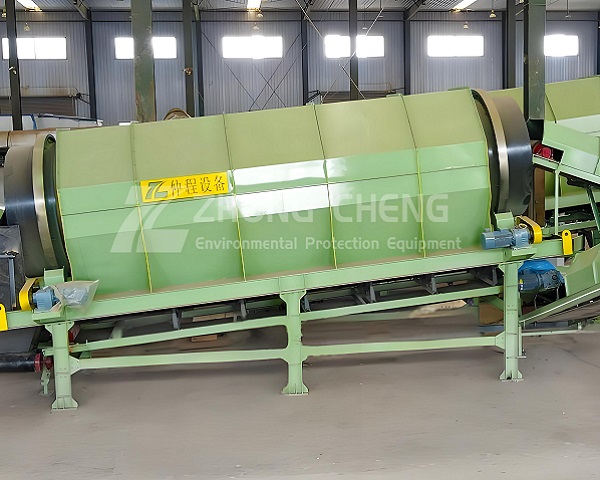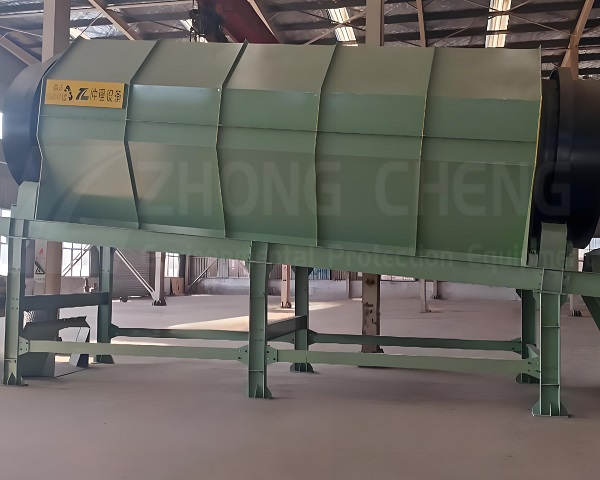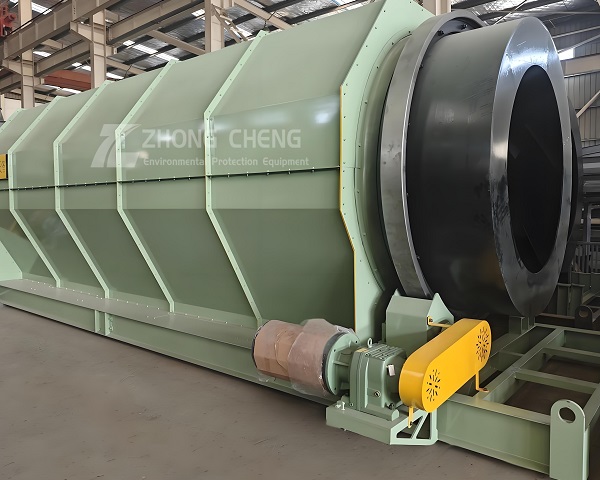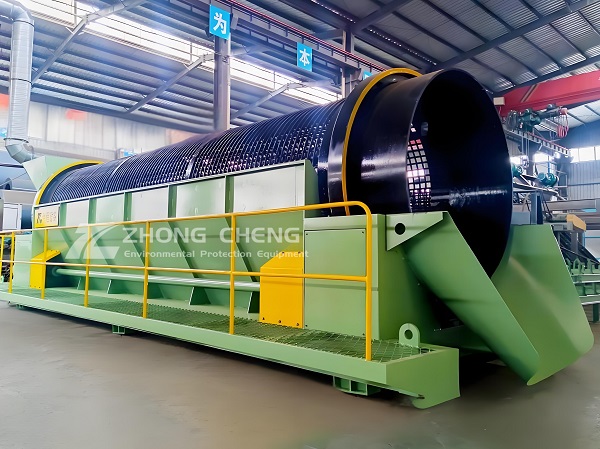As the core equipment for material grading in industries such as mining, building materials, and environmental protection, the installation quality of trommel screendirectly determines their operational stability, screening efficiency, and service life. In actual construction, due to insufficient site preparation, substandard foundation accuracy, and non-standard installation processes, equipment vibration, screen damage, material leakage, and other malfunctions often occur, seriously affecting production. This article focuses on the entire installation process, from preliminary preparation, basic construction, main assembly, auxiliary system installation to acceptance and trial operation, sorting out key precautions and precise parameter requirements, providing standardized operation guidelines for technical personnel, helping to avoid installation hazards, ensuring that the drum screen reaches the design capacity and screening accuracy quickly, and laying the foundation for efficient operation of the production line

A. Preparation stage before installation: core points to avoid potential hazards in the early stage
The preliminary preparation for the installation of the drum screen directly determines the stability of subsequent operation, and it is necessary to focus on controlling the three core elements of the site, equipment, and personnel to prevent blind construction.
1. Precautions for venue and environmental preparation
The site needs to meet the space requirements for equipment operation and maintenance. A maintenance channel of ≥ 1.5 meters should be reserved around the drum screen. The distance between the feeding end and the feeder should be ≥ 0.8 meters, and the distance between the discharging end and the receiving equipment should be ≥ 0.5 meters to avoid mutual interference during operation. The ground bearing capacity needs to match the weight of the equipment. Small trommel screen(processing capacity ≤ 50t/h) require a ground bearing capacity of ≥ 6t/㎡, while large trommel screen(processing capacity ≥ 200t/h) require a ground bearing capacity of ≥ 12t/㎡. Soft ground needs to be reinforced by laying steel plates or pouring concrete cushion layers. At the same time, the site needs to have good drainage conditions to avoid water accumulation causing corrosion of equipment bases; If used in damp or dusty environments (such as construction waste disposal), it is necessary to plan in advance the installation location of rain shelters and dust removal equipment to ensure that motors and electrical components are kept away from water vapor and dust.
2. Precautions for equipment inspection and accessory verification
After opening the box, it is necessary to check the components item by item according to the equipment list, with a focus on checking whether the screen body (screen mesh, screen frame, flange) has been deformed during transportation, whether the welds have cracks or detachment, and whether the screen mesh aperture meets the design requirements and is not damaged or deformed. The transmission system (motor, reducer, idler, stop wheel) needs to be confirmed to match the model, the bearings are not stuck, and the lubricating oil filling port is clean and unobstructed. Vulnerable parts (such as screen mesh and idler bushing) need to be fully stocked and made of the same material as the original equipment (such as polyurethane screen mesh, hardness index needs to be confirmed). Pay special attention to checking the specifications and quantities of anchor bolts, gaskets, couplings, and other connecting components to avoid installation delays caused by mismatched accessories.
3. Precautions for personnel and tool preparation
The installation personnel need to have mechanical installation qualifications, be familiar with the structure principle of the drum screen, conduct technical disclosure in advance, and clarify the installation process and safety regulations. Essential tools need to be verified for accuracy in advance: the accuracy of the level should be ≥ 0.02mm/m, the range of the torque wrench should cover the required torque for installation (usually 50-200N · m), and the rated load of lifting equipment (such as car cranes and manual hoists) should be ≥ 1.2 times the weight of the equipment to avoid lifting risks. At the same time, protective equipment such as insulated gloves, safety helmets, and anti slip shoes should be equipped. Electrical installation must be operated by professional electricians, and unlicensed work is strictly prohibited.

B. Basic construction stage: key requirements for ensuring equipment stability
The foundation of the drum screen is the cornerstone for the long-term stable operation of the equipment, and it is necessary to strictly follow the design drawings to control the concrete strength, levelness, and installation accuracy of the foundation bolts.
1. Precautions for foundation pouring
The foundation needs to be laid out and constructed according to the equipment installation drawings, using concrete of grade C30 or above for pouring. The thickness of the foundation for small trommel screenshould be ≥ 300mm, and for large trommel screenit should be ≥ 500mm. The steel reinforcement configuration should comply with the design standards (usually using Φ 12mm threaded steel with a spacing of 200mm). When embedding anchor bolts, a positioning template should be used to fix them, ensuring that the bolt spacing error is ≤± 2mm, the top elevation error is ≤± 3mm, and the bolt verticality error is ≤ 1mm/m, to avoid subsequent equipment misalignment. After pouring concrete, it needs to be covered and cured for at least 7 days. Equipment installation can only be carried out when the strength reaches 80% or above of the design value. It is strictly prohibited to start construction before reaching the strength.
2. Precautions for basic acceptance
Before installation, a comprehensive acceptance of the foundation is required: the levelness error of the top surface of the foundation should be ≤ 2mm/m, and the surface should be free of defects such as cracks, honeycombs, and rough surfaces; The exposed length of the anchor bolt should meet the installation requirements of the equipment base (usually 10-15mm exposed), and the thread should not be damaged or corroded; There should be no accumulation of debris around the foundation, and the reserved drainage channels and cable trenches should be unobstructed. If the basic levelness does not meet the standard, cement mortar leveling should be used, with a leveling layer thickness of ≥ 20mm. After curing and solidification, the equipment should be placed in place.

C. Main installation phase: Core operating standards for strict precision control
The installation of the main body should follow the principle of "fixing before connecting, rough adjustment before fine adjustment", with a focus on controlling the installation accuracy of the screen body and transmission system to avoid problems such as vibration and movement during operation.
1. Precautions for positioning and fixing the sieve body
Use lifting equipment to smoothly lift the screen body, and the lifting points should be selected at the flange plates or special lifting ears at both ends of the screen body. It is strictly prohibited to directly lift the screen mesh or support wheel axle to prevent deformation of the screen body. After the screen body is in place, adjust the position so that the base bolt holes are accurately aligned with the foundation bolts, and initially tighten the nuts (not to the rated torque temporarily). Use a spirit level to measure the longitudinal and transverse levelness of the sieve body, and calibrate it by adjusting the adjusting gasket (thickness 0.5-10mm) under the base to ensure that the levelness error is ≤ 1mm/m, and the inclination angle of the sieve body meets the design requirements (usually 3 ° -8 °), which facilitates material flow. After the calibration is completed, tighten the anchor bolts in diagonal order, with torque values according to the equipment manual requirements (usually 80-150N · m). After tightening, recheck the levelness to avoid equipment displacement during the tightening process.
2. Precautions for installation of supporting wheels and blocking wheels
The installation of the supporting wheel group must ensure that the parallelism error of the axis of the two supporting wheels is ≤ 0.2mm/m, the height difference of the top surface of the supporting wheels is ≤ 1mm, and the contact area between the supporting wheels and the screen rolling ring is uniform, with a contact area of ≥ 70%, to avoid excessive local stress and wear. The blocking wheel is installed on the outer side of the rolling rings at both ends of the screen body, with a gap of 2-5mm between it and the side of the rolling rings. The gap is uniform and there is no jamming, ensuring that there is no axial movement during the operation of the screen body. The bearings of the supporting and blocking wheels need to be filled with qualified lubricating oil in advance (lithium based grease is recommended), with the oil level reaching 1/2 of the bearing chamber volume. After installation, they should rotate flexibly without any abnormal noise.
3. Precautions for installation of transmission system
The installation of the motor and reducer must ensure that the bottom seat is firmly fixed. The parallelism error between the motor axis and the input shaft axis of the reducer should be ≤ 0.2mm/m, and the deviation of the center distance between the two shafts should be ≤ ± 0.5mm. When using belt transmission, the alignment deviation of the pulley should be ≤ 0.5mm, and the belt tension should be lowered by 10-15mm when pressing the midpoint of the belt. Over tightening can easily cause the bearing to overheat, while over loosening can cause slippage; When using gear transmission, the gear mesh clearance should be controlled at 0.2-0.5mm, the contact area of the meshing surface should be ≥ 60%, and there should be no tooth biting phenomenon. When connecting the coupling, the coaxiality error should be ≤ 0.1mm, the end face clearance should be maintained at 3-5mm, and the elastic pad should be installed in place without displacement or missing.
4. Precautions for screen installation
Before installing the screen mesh, it is necessary to clean the debris inside the screen frame to ensure a smooth fitting surface. The fixing of the screen mesh and screen frame should be firm. When using bolts for fixing, the bolt spacing should be ≤ 150mm, and spring washers should be installed to prevent loosening; When using a tensioning device for fixation, the screen mesh should be evenly tensioned to avoid local looseness that may cause material accumulation or damage to the screen mesh. When installing multi-layer screen mesh, it is necessary to ensure that the aperture of each layer of screen mesh corresponds, and the seams of the screen mesh are staggered and overlapped with a width of ≥ 50mm to prevent material leakage from the seams. After installation, manually rotate the screen body and check that the screen mesh is not scratched or stuck, and rotates flexibly.

D. Precautions for installing auxiliary systems
The installation quality of auxiliary systems (pipelines, electrical, dust prevention) directly affects the safety and environmental protection of equipment operation, and relevant specifications must be strictly followed.
1. Precautions for pipeline connection
Sealing gaskets (made of wear-resistant and corrosion-resistant materials such as rubber or polyurethane) should be installed at the interface between the inlet and outlet pipes and the screen body. The bolts should be tightened evenly to ensure good sealing and no leakage or air leakage. The installation of pipelines should be kept smooth, avoiding sharp bends (bending angle ≥ 90 °), and the slope of the feeding pipe should be ≥ 30 ° to facilitate material flow and reduce the risk of blockage; The discharge pipe needs to be equipped with support brackets to prevent the weight of the pipeline from directly acting on the sieve body, causing deformation of the sieve body. If equipped with a chute, the inner wall of the chute should be smooth, aligned with the discharge port of the screen, with a spacing of ≤ 100mm to prevent material splashing.
2. Precautions for Electrical System Installation
Electrical installation must strictly follow the "Code for Construction and Acceptance of Electrical Equipment Installation Engineering". The wiring between motors, sensors (such as level sensors and vibration sensors) and control cabinets should be firm and standardized, with clear terminal numbers and a grounding resistance of ≤ 4 Ω for the grounding wire. The control cabinet should be installed in a dry, ventilated, and easy to operate location, with a distance of at least 1 meter from the equipment to avoid vibration affecting electrical components. After installation, check the continuity of the electrical circuit, test the functions of the emergency stop button, indicator light, frequency converter, etc., and ensure that the motor direction is consistent with the equipment identification arrow.
3. Precautions for installation of dust and safety devices
In scenes with high levels of dust, a fully sealed cover should be installed. The sealing cover should be tightly sealed at the interface with the screen and pipeline. When used in conjunction with a pulse dust collector, the dust removal pipeline should be connected smoothly with minimal resistance loss. Safety protection devices (such as protective covers for pulleys, gears, and belt pulleys) must be installed firmly, with a distance of ≥ 50mm between the protective cover and moving parts. It is strictly prohibited to remove or damage them. Protective barriers should be set up around the equipment, with a height of ≥ 1.2 meters and clear warning signs to remind operators to pay attention to safety.

E. Acceptance and safety regulations after installation
After installation, comprehensive acceptance and trial operation are required to ensure that the equipment meets operational requirements, while strictly adhering to safety operating standards.
1. Precautions for installation and acceptance
Key inspection during acceptance: The connecting bolts of each component are securely fastened and not loose; The levelness and inclination angle of the sieve body meet the design requirements; The transmission system runs smoothly without any abnormal noise or vibration; The screen mesh is securely installed without any damage or leakage; Electrical system wiring specifications, reliable grounding; The safety protection devices are complete and effective. At the same time, verify the installation records to ensure that all parameters meet the standards and keep the acceptance report for record keeping.
2. Safety precautions for trial operation
Before trial operation, it is necessary to clean the interior and surrounding debris of the equipment again, check the lubricating oil level, and ensure that there are no abnormalities in the electrical circuits. During the no-load test run, first jog the motor and observe that the direction of rotation of the screen body is correct, without any jamming or abnormal noise. Then run continuously for 2-4 hours, monitoring the motor current (should be between 30% -50% of the rated current), bearing temperature (≤ 75 ℃), vibration speed (≤ 4.5mm/s), and no leakage or overheating. During the load test run, gradually increase the feeding amount to avoid one-time full load feeding, observe the material screening effect, ensure no blockage or leakage, and achieve the sorting accuracy standard. During the trial operation, the operator should stay away from moving parts. If any abnormalities occur, immediately press the emergency stop button, cut off the power, and troubleshoot.
3. Precautions for pre maintenance in the later stage
After installation, it is necessary to hand over equipment manuals, installation drawings, acceptance reports, and other materials to the operators, conduct operation and maintenance training, and clarify daily inspection points (such as bolt tightening, lubricant replenishment, and screen cleaning). Establish a maintenance ledger to record installation dates, trial operation parameters, vulnerable parts models, and other information, providing a basis for subsequent maintenance.
The installation of trommel screenrequires adherence to the three principles of "precise control, standardized operation, and comprehensive acceptance". From the detailed preparation of the site and equipment in the early stage, to the strength and precision control of the foundation construction, to the precise assembly of the main body and auxiliary systems, each link directly affects the performance of the equipment. By strictly controlling key parameters such as levelness and coaxiality, standardizing the connection and fixing process, and improving safety and dust prevention devices, problems such as vibration, material leakage, and component wear can be effectively avoided. The no-load and load trial operation after installation, as well as pre maintenance, can further ensure the long-term stable operation of the equipment. The precautions and operating standards described in this article can help enterprises reduce installation risks and maintenance costs, fully utilize the grading efficiency of drum screens, and provide reliable guarantees for improving production quality and efficiency.
Save Time! Get A Detailed Quotation Quickly.
